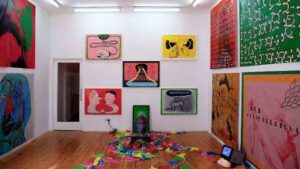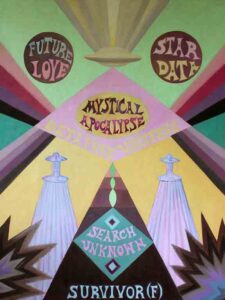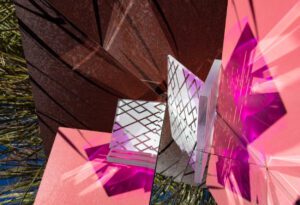
Robin Spalding speaks to Mark Rohtmaa Jackson and Lindsay Friend about the 20 year history IMT Gallery, one of London’s most vibrant artist-run spaces.
Robin Spalding (RS): What were your aims when you started IMT in 2005?
Mark Rohtmaa-Jackson M R-J): Both of us were artists and we were frustrated with the different art-scenes that we were involved in previously. We wanted to show artists whose works resisted commodification and weren’t angled towards the commercial market.
Lindsay Friend (LF): I felt that the opportunities to exhibit interesting work were limited for the artists that we wanted to work with. Certain things were getting overlooked, so we were filling holes.
RS: I’ve noticed that resistance to power seems to be a common thread in your programme. Is this deliberate?

Compression (2019)
Installation view courtesy of the artist and IMT Gallery
LF: I think it’s just part of our naughty personalities!
MR-J: It has become an important part of what IMT does. We often work with artists that have that political interest. I’m sure that they feel more comfortable in an environment that has a history of working on exhibition projects that address power.
RS: Can you speak about the ‘hybrid model’ – how IMT positions itself somewhere between a commercial gallery and a non-profit organisation?
MRJ: The hybridity of IMT runs through the whole project. It’s not just about being commercial and non-profit, it’s also about the fact that we are artist-curators as well as the live-work situation of the gallery. There’s no way that IMT could survive without it also being Lindsay’s home. We have found ourselves needing to be on the threshold between two positions at all times in order for the gallery to survive. Also, part of IMT’s identity is that the edges are cracked. It has an eccentricity that comes from being positioned between professionalism and amateurism, which is quite a nice place to be.
RS: Can you talk a bit more about the narrative that guides what IMT decides to address in terms of subject matter?
MRJ: A lot of the ideas and conversations that we work with are about creating alternatives. And a lot of that comes from Simon [O’ Sullivan] and David [Burrows] ideas around fictioning alternatives – where we want things to be. What art making and exhibition making can be. We are building a narrative for IMT. It’s a fictional third mind.
RS: I see a sort of science-fiction type modelling of future dystopias theme running through many of your exhibitions, for example in the works of artists like Plastique Fantastique and John Powell Jones.
MRJ: All of these exhibitions are 100% political. Science fiction is one of the places where you can tell good stories whilst also telling important stories. It’s about suggesting alternatives rather than creating dystopias.
RS: Which projects do you think have been the most successful in IMT Gallery’s history?
LF: One of the best shows ever was Yak Beow Seah and Chong Boon Pok’s P&S Recipe Shop in 2006.
MRJ: That was the second show that we did. The gallery was transformed into a functioning Malaysian style café, so it was a relational aesthetics type project. Nobody really knew what the space was at that point. Was it a café? Was it a social space? Was it an art gallery? Another exhibition that had some amazing artists in it was Obliteration Device in 2014 which David Burrows curated. It was a show about obliterating ideas and aesthetics. As a result, it was kind of complex and angry and punk. That’s the kind of show that couldn’t happen in very many spaces, that perhaps could only happen with us.
RS: I like the idea of IMT having a punk aesthetic. That’s very much how I see your identity. It’s great that you support those little veins of punk within contemporary culture.
LF: Someone recently said that we were like a really good punk zine from the 1970s. “Doesn’t sound like a sustainable business to me…” [laughs].
LF: Whilst on that subject, can we talk about how Plastique Fantastique are overlooked in the commercial art world?

oil on canvas
Image courtesy the artist and IMT Gallery
MRJ: Tai Shani talked about how Plastique Fantastique should be more acknowledged than they are for feeding into the aesthetics of the London art scene at the moment. David [Burrows] obviously teaches at the Slade and Simon [O’Sullivan] teaches at Goldsmiths, so they do have a network of people seeing what they are up to. But maybe that influence is only visible if you start scratching the surface. They are a good example of the type of artists that we work with, that defy commodification.
LF: I’m currently quite angry about the commercial art world, particularly the art fair market. I really don’t think the art fair market is there for galleries that show emerging artists or emerging spaces, which I feel is a big problem. It’s a horrible experience.
MRJ: We were once at The Manchester Contemporary art fair during the early days of IMT. There’s an awkwardness about these events because there’s just a hideousness of being in sales, of promoting things endlessly. And so we just started chanting “death” really loudly on the stand…
LF: It was a spontaneous thing! For me it was like “we’ve had enough”. There was a
universal understanding that we all felt the same.
MRJ: It wasn’t that we were wanting the collectors to die. We were embracing the bleakness of capitalism. “Death” was a kind of pagan celebration of mortality, of corpses. And that’s what we were dealing with. Artwork that has come out of life and been turned into dead objects to be put through the money nexus. We struggle with being part of a system like the art market which is incredibly manipulative and exploitative of the people involved in it. Trying to support artists that we like within a system that’s quite violent and structurally problematic is …we have to sometimes chant “death”.
RS: Mark, can you talk a little about your recent book about your experience of curating IMT Gallery?
MRJ: I thought that a book about IMT would be different from a lot of the other available books about curating and gallery management. It’s an academic book but at the same time it slips between formal academic speech and stories about the gallery. It’s part of a Routledge series on the global cultural economy, so it’s part of a broader conversation around organising culture. As we are talking about Fictioning and performing different narratives: this is a way of performing in academic publishing. The book is kind of an intervention into academic publishing by IMT Gallery as a kind of mutant entity. In the book I describe IMT as a fantasy monster-hydra-vampire-thing that kind of intervenes into academic discourse. That’s how I see it.

